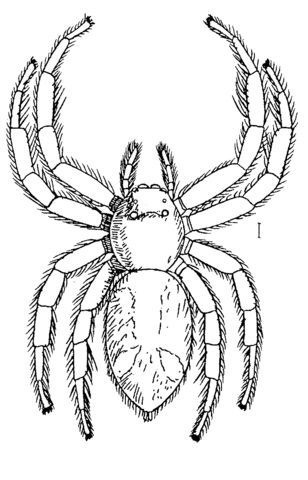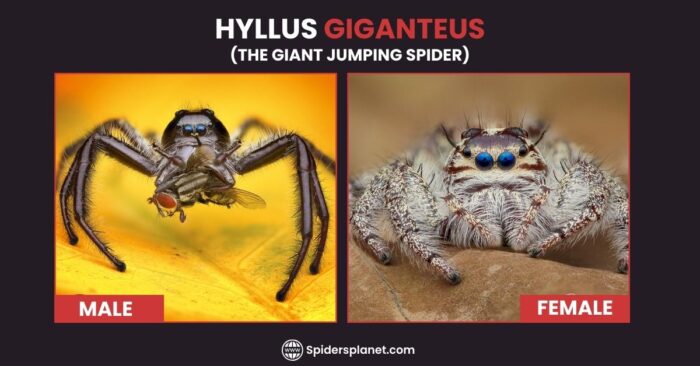Jumping spiders are a small arachnids. Arachnids are a big group that includes various spiders, scorpions, harvestmen, and others. Jumping spiders are part of a specific group called Salticidae. The Giant jumping spider is known as Hyllus giganteus.
Hyllus giganteus is known as the largest jumping spider, found in Australia and Sumatra. What makes this little arachnid stand out? It can leap an incredible eight times its body length.

This amazing skill equally intrigues scientists and those scared of spiders, turning the Hyllus giganteus into a captivating subject of study and occasional fear. C. L. Koch first identified it in 1846, featuring it in his famous work “The Arachnids.”
The spider is renowned not only for its incredible jumping prowess but also for its distinctive coloration, intricate mating rituals, and intriguing behaviors.
Join us in the fascinating world of giant jumping spiders to learn and know more about their appearance, habitat, diet, mating, and the secrets that make them an extraordinary species in the arachnid realm. Let’s start….!
Hyllus Giganteus Description:
Scientific Name, Specie, and Family:
The scientific name of the giant jumping spider is Hyllus giganteus, with “Hyllus” representing its genus and “giganteus” its species (H. giganteus). It belongs to the Animalia kingdom and falls under the Arachnida class within the Salticidae family.
Within the Salticidae family, it is specifically classified under the Salticinae subfamily.
What does a Giant Jumping Spider look like?
Size:
Giant jumping spiders typically measure between 1.8 to 2.5 centimeters (0.71 to 0.98 inches) in length. The largest known jumping spider species is the giant jumping spider (Hyllus giganteus).
Females can grow up to 2.5 cm (1 inch) in body length, while males are smaller, reaching up to 1.8 cm (0.7 inches).
Hyllus Giganteous has a Unique Eye Arrangement:
Similar to other jumping spiders, giant jumping spiders, including Hyllus giganteus, possess eight eyes arranged in four pairs, with a significant pair of large eyes located in the middle of its head.
Following are the facts for their excellent eye vision:
- The principal eyes work like binoculars, surrounded by additional pairs of eyes.
- The principal eyes have a distinctive inner lens that magnifies images from the larger outer lens.
- Large muscles attached to the retina enable up-and-down movement, enhancing image focus.
- The outer pairs of eyes provide crucial peripheral vision for the Giant Jumping Spider.
- The large jumping spiders can perceive blue, green, red, and orange, making them one of the few spider species with color vision.
- The presence of four pairs of eyes enhances their hunting capabilities, contributing to their remarkable visual prowess.
- This unique adaptation allows them to see colors, including ultraviolet light.
- Giant jumping spiders, like others in their species, can perceive depth. Their remarkable eyes have evolved with four layers of photoreceptors, each capturing a different color.
Color:
The giant jumping spider is known for its diverse colors. Males have dark bodies with white or yellow markings, including bands and stripes, and some may have iridescence scales that give them a metallic sheen.
Females, while less colorful, still display brown, gray, or black tones with lighter markings. Common colors include black, brown, white, yellow, and iridescent for males and brown, gray, black, reddish, or orange for females.
Specific colors vary based on age, sex, and location, but the dark body with contrasting markings is a consistent theme.
Identification:
For identification, do not mix up the giant jumping spider, Hyllus giganteus, with its smaller cousin, Hyllus diardi, which only grows to a length of 0.59 inches.
Various characteristics can help distinguish the world’s largest jumping spider, such as looking for distinct features like white stripes on the top of their “face”. A black band runs across their head, accompanied by two white lines down their sides.
This unique combination of markings helps differentiate giant jumping spiders from other species and allows you to distinguish between males and females based on their colors.
Habitat and Discovery:
In 1846, German spider specialist Carl Ludwig Koch discovered the first giant jumping spider. These spiders are originally from Sumatra and Australia, living in forests and dwelling in trees.
Unlike other spiders that spin webs, giant jumping spiders do not make webs. Instead, they wander through their forest homes in search of prey, catching them by jumping on them.
Hunting:
Big jumping spiders hunt during the day, showing off their clever moves. They chase their prey with skill and outstanding vision; this spider can jump up to 20 times its body length to catch its prey, showcasing impressive hunting skills.
To land safely, they use special thin silk “anchors” for protection and to guide them in the air.
What They Like to Eat?
Their varied diet includes flies, mealworms, other spiders, and even grasshoppers, highlighting their adaptability and effective hunting techniques.
Largest Jumping Spider Mating and Lifecycle:
The male giant jumping spiders have a unique way of finding a female giant jumping spider. They do special dances, moving their bodies and showing off their bright colors to impress them.

These spiders produce sounds by rubbing their body parts and drumming on the ground. They repeatedly perform these dances to locate the perfect female spider and avoid the risk of being mistakenly eaten.
Male giant jumping spiders use special body parts called pedipalps to give female spiders packages of sperm. This starts the process of making babies.
After the female gets the sperm, she lays about 100 eggs in a safe place and takes good care of them until they hatch. The biggest female spiders only mate once, choosing a special male partner.
After mating, the female puts the eggs in a cocoon for three to four weeks. Later, baby spiders(spiderlings) come out of the cocoon four to six weeks later and leave their nest.
Predators:
Huntsman spiders face a range of predators in their ecosystems, including birds, geckos, spiders, and wasps.
Are they Venomous?
Although it can be surprising to come across a giant jumping spider, if it bites you, there is generally no need to worry. Giant jumping spiders are not venomous to humans, and any reaction to a bite is usually mild and temporary, resulting in a welt similar to a mosquito bite.
Also Read:
FAQs:
Is their bite dangerous?
The bites from these largest spiders pose no significant threat to humans because their venom lacks the potency to induce serious harm. In general, their bites are not characterized by intense pain.
Are giant jumping spiders good pets?
Individuals who are new to pet ownership may find these spiders less than ideal. The spiders’ larger size, which could pose challenges for beginners, their tendency to get easily frightened, and specific care requirements, such as needing a significant amount of space and a particular diet, are contributing factors.
Demand a higher level of experience and commitment in terms of care and handling.
How to care for these spiders?
For the Giant Jumping Spider (Hyllus Giganteus), a spacious 10-gallon enclosure with good ventilation and hiding spots is essential. Maintain temperatures between 75 and 85 degrees Fahrenheit using a heat source.
Keep humidity levels at 60-70% with daily misting. Feed them a carnivorous diet of live insects like crickets and roaches. Though not aggressive, it’s best to avoid handling these spiders due to their tendency to startle easily.
What is the lifespan of the largest jumping spider?
The lifespan of these biggest jumping spiders is typically between 1 and 3 years.
Are Giant jumping spiders aggressive?
These spiders are not known for being friendly. While they are not inherently aggressive, they easily get startled or frightened. It is recommended to avoid handling them as a precaution to prevent causing stress or fear in these creatures.
Final Thoughts with Quick Facts:
- The largest known jumping spiders are giant jumping spiders, with females reaching up to 2.5 cm and males reaching 1.8 cm.
- Despite their size, they can leap up to 20 times their body length, aiding in hunting and escaping predators.
- With eight eyes, including two large forward-facing ones, they have excellent vision crucial for hunting and detecting movement.
- Males have vibrant markings, while females have more subdued colors like brown, gray, or black.
- During courtship male spiders make dances with vibrant markings to allure female spiders.
- They feed on insects and spiders, utilizing their jumping ability and keen vision.
- Native to Southeast Asia, they inhabit rainforests in countries like Sumatra, Java, Sulawesi, and Borneo.
- Not considered dangerous, their bites may cause mild pain and swelling if provoked.




Leave a Reply